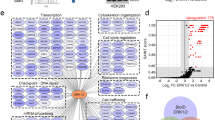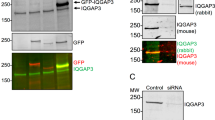Abstract
Up to one-third of human melanomas are characterized by an oncogenic mutation in the gene encoding the small guanosine triphosphatase (GTPase) NRAS. Ras proteins activate three primary classes of effectors, namely, Rafs, phosphatidyl-inositol-3-kinases (PI3Ks) and Ral guanine exchange factors (RalGEFs). In melanomas lacking NRAS mutations, the first two effectors can still be activated through an oncogenic BRAF mutation coupled with a loss of the PI3K negative regulator PTEN. This suggests that Ras effectors promote melanoma, regardless of whether they are activated by oncogenic NRas. The only major Ras effector pathway not explored for its role in melanoma is the RalGEF–Ral pathway, in which Ras activation of RalGEFs converts the small GTPases RalA and RalB to an active guanosine triphosphate-bound state. We report that RalA is activated in several human melanoma cancer cell lines harboring an oncogenic NRAS allele, an oncogenic BRAF allele or wild-type NRAS and BRAF alleles. Furthermore, short hairpin RNA (shRNA)-mediated knockdown of RalA, and to a lesser extent of RalB, variably inhibited the tumorigenic growth of melanoma cell lines having these three genotypes. Thus, as is the case for Raf and PI3 K signaling, Rals also contribute to melanoma tumorigenesis.
This is a preview of subscription content, access via your institution
Access options
Subscribe to this journal
Receive 50 print issues and online access
$259.00 per year
only $5.18 per issue
Buy this article
- Purchase on Springer Link
- Instant access to full article PDF
Prices may be subject to local taxes which are calculated during checkout




Similar content being viewed by others
References
Bodemann BO, White MA . (2008). Ral GTPases and cancer: linchpin support of the tumorigenic platform. Nat Rev Cancer 8: 133–140.
Bodempudi V, Yamoutpoor F, Pan W, Dudek AZ, Esfandyari T, Piedra M et al. (2009). Ral overactivation in malignant peripheral nerve sheath tumors. Mol Cell Biol 29: 3964–3974.
Chien Y, Kim S, Bumeister R, Loo YM, Kwon SW, Johnson CL et al. (2006). RalB GTPase-mediated activation of the IkappaB family kinase TBK1 couples innate immune signaling to tumor cell survival. Cell 127: 157–170.
Chien Y, White MA . (2003). RAL GTPases are linchpin modulators of human tumour-cell proliferation and survival. EMBO R 4: 800–806.
D'Adamo DR, Novick S, Kahn JM, Leonardi P, Pellicer A . (1997). rsc: a novel oncogene with structural and functional homology with the gene family of exchange factors for Ral. Oncogene 14: 1295–1305.
de Gorter DJ, Reijmers RM, Beuling EA, Naber HP, Kuil A, Kersten MJ et al. (2008). The small GTPase Ral mediates SDF-1-induced migration of B cells and multiple myeloma cells. Blood 111: 3364–3372.
Downward J . (2003). Targeting RAS signalling pathways in cancer therapy. Nat Rev Cancer 3: 11–22.
Falsetti SC, Wang DA, Peng H, Carrico D, Cox AD, Der CJ et al. (2007). Geranylgeranyltransferase I inhibitors target RalB to inhibit anchorage-dependent growth and induce apoptosis and RalA to inhibit anchorage-independent growth. Mol Cell Biol 27: 8003–8014.
Feig LA . (2003). Ral-GTPases: approaching their 15 min of fame. Trends Cell Biol 13: 419–425.
Gonzalez-Garcia A, Pritchard CA, Paterson HF, Mavria G, Stamp G, Marshall CJ . (2005). RalGDS is required for tumor formation in a model of skin carcinogenesis. Cancer Cell 7: 219–226.
Gray-Schopfer V, Wellbrock C, Marais R . (2007). Melanoma biology and new targeted therapy. Nature 445: 851–857.
Hamad NM, Elconin JH, Karnoub AE, Bai W, Rich JN, Abraham RT et al. (2002). Distinct requirements for Ras oncogenesis in human versus mouse cells. Genes Dev 16: 2045–2057.
Khosravi-Far R, White MA, Westwick JK, Solski PA, Chrzanowska-Wodnicka M, Van Aelst L et al. (1996). Oncogenic Ras activation of Raf/mitogen-activated protein kinase-independent pathways is sufficient to cause tumorigenic transformation. Mol Cell Biol 16: 3923–3933.
Lim KH, Baines AT, Fiordalisi JJ, Shipitsin M, Feig LA, Cox AD et al. (2005). Activation of RalA is critical for Ras-induced tumorigenesis of human cells. Cancer Cell 7: 533–545.
Lim KH, Brady DC, Kashatus DF, Ancrile BB, Der CJ, Cox AD et al. (2010). Aurora-A phosphorylates, activates, and relocalizes the small GTPase RalA. Mol Cell Biol 30: 508–523.
Lim KH, O'Hayer K, Adam SJ, Kendall SD, Campbell PM, Der CJ et al. (2006). Divergent roles for RalA and RalB in malignant growth of human pancreatic carcinoma cells. Curr Biol 16: 2385–2394.
Miller MJ, Rioux L, Prendergast GV, Cannon S, White MA, Meinkoth JL . (1998). Differential effects of protein kinase A on Ras effector pathways. Mol Cell Biol 18: 3718–3726.
Mishra PJ, Ha L, Rieker J, Sviderskaya EV, Bennett DC, Oberst MD et al. (2010). Dissection of RAS downstream pathways in melanomagenesis: A role for Ral in transformation. Oncogene 29: 2449–2456.
Oxford G, Owens CR, Titus BJ, Foreman TL, Herlevsen MC, Smith SC et al. (2005). RalA and RalB: antagonistic relatives in cancer cell migration. Cancer Res 65: 7111–7120.
Rosse C, Hatzoglou A, Parrini MC, White MA, Chavrier P, Camonis J . (2006). RalB mobilizes the exocyst to drive cell migration. Mol Cell Biol 26: 727–734.
Sablina AA, Chen W, Arroyo JD, Corral L, Hector M, Bulmer SE et al. (2007). The tumor suppressor PP2A Abeta regulates the RalA GTPase. Cell 129: 969–982.
Smith SC, Oxford G, Baras AS, Owens C, Havaleshko D, Brautigan DL et al. (2007). Expression of Ral GTPases, their effectors, and activators in human bladder cancer. Clin Cancer Res 13: 3803–3813.
Sowalsky AG, Alt-Holland A, Shamis Y, Garlick JA, Feig LA . (2009). RalA suppresses early stages of Ras-induced squamous cell carcinoma progression. Oncogene 29: 45–55.
Urano T, Emkey R, Feig LA . (1996). Ral-GTPases mediate a distinct downstream signaling pathway from Ras that facilitates cellular transformation. EMBO J 15: 810–816.
White MA, Vale T, Camonis JH, Schaefer E, Wigler MH . (1996). A role for the Ral guanine nucleotide dissociation stimulator in mediating Ras-induced transformation. J Biol Chem 271: 16439–16442.
Wolthuis RM, Franke B, van Triest M, Bauer B, Cool RH, Camonis JH et al. (1998). Activation of the small GTPase Ral in platelets. Mol Cell Biol 18: 2486–2491.
Wu JC, Chen TY, Yu CT, Tsai SJ, Hsu JM, Tang MJ et al. (2005). Identification of V23RalA-Ser194 as a critical mediator for Aurora-A-induced cellular motility and transformation by small pool expression screening. J Biol Chem 280: 9013–9022.
Yin J, Pollock C, Tracy K, Chock M, Martin P, Oberst M et al. (2007). Activation of the RalGEF/Ral pathway promotes prostate cancer metastasis to bone. Mol Cell Biol 27: 7538–7550.
Acknowledgements
This work is supported in part by an American Cancer Society Grant to PAZ, a Leukemia & Lymphoma Fellowship to DFK, a Veterans Affairs Merit Review Grant to DST and a National Institutes of Health grant (CA94184) to CMC. We thank Dr Hillard Siegler (Duke University Medical Center) for all melanoma cell lines except SKMel28 cells.
Author information
Authors and Affiliations
Corresponding authors
Ethics declarations
Competing interests
The authors declare no conflict of interest.
Additional information
Supplementary Information accompanies the paper on the Oncogene website
Supplementary information
Rights and permissions
About this article
This article is cited by
-
The role of ral signaling and post translational modifications (PTMs) of Ras in cancer
Genome Instability & Disease (2022)
-
The RAS-RAL axis in cancer: evidence for mutation-specific selectivity in non-small cell lung cancer
Acta Pharmacologica Sinica (2015)
-
Discovery and characterization of small molecules that target the GTPase Ral
Nature (2014)
-
Copper is required for oncogenic BRAF signalling and tumorigenesis
Nature (2014)
-
Targeted therapy for melanoma: rational combinatorial approaches
Oncogene (2014)



